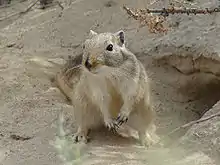Great gerbil
The great gerbil (Rhombomys opimus) is a large rodent found throughout much of Central Asia.
| Great gerbil | |
|---|---|
 | |
| Scientific classification | |
| Kingdom: | Animalia |
| Phylum: | Chordata |
| Class: | Mammalia |
| Order: | Rodentia |
| Family: | Muridae |
| Genus: | Rhombomys Wagner, 1841 |
| Species: | R. opimus |
| Binomial name | |
| Rhombomys opimus (Lichtenstein, 1823) | |
Description
The largest of the gerbils, great gerbils have a head and body length of 15–20 cm (6–8 in). Their skulls are distinctive by having two grooves in each incisor. They have large front claws used for burrowing.[2]
Distribution and habitat
Great gerbils are found in arid habitats, predominantly in sandy or clay deserts. They are found in Turkmenistan, Kazakhstan, Mongolia, China, Pakistan, Afghanistan, and Iran.[1]
Ecology and behavior
Great gerbils live in family groups and occupy one burrow per family.[3] Their burrows can be fairly extensive with separate chambers for nests and food storage. Great gerbils spend considerably more time in the burrows during winter, but do not hibernate. They are predominantly diurnal. Food consists mostly of vegetable matter.[2]
The animals are often colonial. Longevity is 2–4 years. Burrow system complexes have a distinctive region of cleared soil and can be seen and mapped from aerial photos and satellite images.[4] Inhabited great gerbil burrows can be distinguished from abandoned burrows using satellite images .[5]
Great gerbils are known reservoirs of Yersinia pestis, the bacterium that causes plague, and of Leishmania major, the causative agent of zoonotic cutaneous leishmaniasis. They are also known as crop pests and have been implicated in exacerbating erosion.
References
- Shar, S.; Lkhagvasuren, D.; Molur, S. (2008). "Rhombomys opimus". IUCN Red List of Threatened Species. 2008. Retrieved 28 May 2012.CS1 maint: ref=harv (link)
- Smith, Andrew T.; Xie, Yan; Hoffmann, Robert S.; Lunde, Darrin; MacKinnon, John; Wilson, Don E.; Wozencraft, W. Chris (2010). A Guide to the Mammals of China. Princeton University Press. p. 251. ISBN 978-1-4008-3411-2.
- Randall, J.A. (2005). "Flexible social structure of a desert rodent, Rhombomys opimus: philopatry, kinship, and ecological constraints". Behavioral Ecology. 16 (6): 961–973. doi:10.1093/beheco/ari078.
- Wilschut, L.I.; Addink, E.A.; Heesterbeek, J.A.P.; Dubyanskiy, V.M.; Davis, S.A; Laudisoit, A.; Begon, M.; Burdelov, L.A.; Atshabar, B.B; de Jong, S.M. (2013). "Mapping the distribution of the main host for plague in a complex landscape in Kazakhstan: An object-based approach using SPOT-5 XS, Landsat 7 ETM+, SRTM and multiple Random Forests". International Journal of Applied Earth Observation and Geoinformation. 23 (100): 81–94. doi:10.1016/j.jag.2012.11.007. PMC 4010295. PMID 24817838.
- Wilschut, L.I; Heesterbeek, J.A.P.; Begon, M.; De Jong, S.M.; Ageyev, V.; Laudisoit, A.; Addink, E.A. (2018). "Detecting plague-host abundance from space: Using a spectral vegetation index to identify occupancy of great gerbil burrows". International Journal of Applied Earth Observation and Geoinformation. 64: 249–255. doi:10.1016/j.jag.2017.09.013. PMC 5763245. PMID 29399006.
- Nowak, R. M. (1999). Walker's Mammals of the World. 2. London: Johns Hopkins University Press.
External links
 Media related to Rhombomys opimus at Wikimedia Commons
Media related to Rhombomys opimus at Wikimedia Commons
